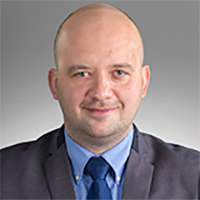
CEMBA Alums Launch Blockchain Startup
Thursday, October 21, 2021
When Sony Malhotra, ’21 CEMBA, began the Carlson Executive MBA (CEMBA) program two years ago, he was already interested in blockchain technology.
Cryptocurrencies such as Bitcoin and Ethereum have always been areas of passion for Malhotra, and throughout his time in the CEMBA program, he would often find himself thinking about how he could apply the lessons he was learning to cryptocurrency and blockchain technology.
It wasn’t long until he found fellow classmates with a shared interest in blockchain and distributed ledger technology. Ignoring the risk of starting a business during a global pandemic, Malhotra, Alexander Drofa, and Joel Haugen founded Sonarch.io in February 2021.
Understanding how Sonarch works as a business involves knowing how blockchains and cryptocurrency function. Blockchain technology refers to a system of recording information in a way that aims to prevent hacking or cheating of the system. In terms of cryptocurrency, blockchains create a digital ledger that keeps a record of transactions.
Cryptocurrency only exists digitally. Unlike physical currency, there is no central issuing or regulating authority. Instead, it’s a decentralized network that records transactions that rely on code, cryptography, and game theory—modeling of strategic interactions between competing players—to prevent counterfeiting and fraud.
Within this framework, there is a role for Sonarch. The company is designed to “validate” transactions on the network. Sonarch competes with other validators to post new transactions to the blockchain.
“We earn a reward each time we are successful,” Malhotra says. “This helps secure and decentralize the network creating a win-win situation for us and the protocol.”
One of the forms of cryptocurrency Sonarch handles is Bitcoin, which is categorized as a “proof of work” (PoW) cryptocurrency. In simple terms, a PoW requires members of a network to expend effort solving an arbitrary mathematical puzzle to prevent the system from being cheated. There is some concern about the amount of energy used by the Bitcoin network. According to the Cambridge Center for Alternative Finance (CCAF), Bitcoin currently consumes around 110 Terawatt Hours per year. That translates to about 0.55% of global electricity production—roughly equivalent to the energy use of a small country.
Newer cryptocurrencies have a different model. Instead of energy, they utilize ownership and game theory to secure the blockchain. This model is called “proof of stake.” In this model, people delegate tokens to operators who they believe will act in the interest of the protocol. It creates a more efficient way to secure a network as compared to Bitcoin’s computing power usage.
The Sonarch website compares staking to earning interest in a bank account. With each coin, Sonarch has delegated the “higher probability we have to validate the next block in the chain,” claims the site. “If we validate a transaction, everyone delegators and validators shares in rewards.”
Malhotra hopes the company will grow to support more protocols and is interested in expanding into health care. With a website relaunch coming soon, they’re stepping up to educate the public about crypto, blockchain, and staking. As he looks to the future, Malhotra knows what he learned throughout the CEMBA program has helped him.
“My Carlson School experience has been extremely valuable to better understand blockchain and speculate if this was going to be a new way of doing business,” Malhotra says.
Sonarch isn’t Malhotra’s only professional commitment. He is also the vice president of service and operations at Ameriprise Financial.
“Through the Carlson School’s MBA program, I have more confidence in all of my professional decisions,” he says. “The courses, my cohorts, and access to the CEMBA professors helped me build a valuable network and be confident. I’ve enjoyed being immersed in the community of a top-tier executive MBA program. It was worth the effort.”


